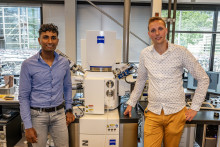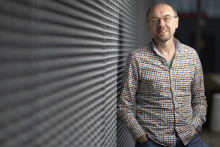He called his project ‘the thing.’ Schippers loathes intellectual swagger. Defiant, anti-authoritarian, original and versatile: songwriter, playwright, radio and TV maker, presenter of the Nationale Wetenschapsquiz and Zomergasten, the voice of Ernie and Kermit on the Dutch version of Sesame Street...
The campus is home to many pieces of modern art. That is all due to the one-percent scheme: one percent of the construction cost of new government buildings was reserved for art. That scheme was introduced after the end of the Second World War to create more work for artists. After all, the years of crisis and war had left many of them living in a state of destitution. Generally speaking, such art had to be affixed on the in- or outside of a building, such as a mural or a relief on a façade. When Twente Technical College was established in 1961, it started out with plenty of land but no buildings. An exception was made to allow the TTC to use the scheme to purchase art that was placed in the vicinity of new buildings. That was why five artists were invited to submit their designs for the space around de Vrijhof in 1978. Schippers was one of those lucky few. His initial idea was to throw the pond in front of the building full of kale. His partner - who possessed more business sense than Schippers - put a stop to that: non-conformism is a fine ideal, but at times one has no choice but to accept the reality of rules and criteria. Schippers then came up with the idea for the submerged steeple. Much to his surprise, a vast majority of staff and students voted for his design - including his suggestion that false stories about the tower had to spread. Was there an entire farming village hidden under the water?
Deliberately spreading falsehoods in an environment where scientists do their best to disprove false theories or conclusively demonstrate the veracity of their hypotheses - how is that for provocation? After all, the campus is generally governed by common sense. In a way, Schippers’ intent to sow misinformation was him thumbing his nose at science.
Does the submerged church tower make a mockery of religion? Schippers never talked about that. Religious faith simply has no place in his absurdist universe. Nevertheless, I interpret his church steeple as a symbol of a different kind of meaning, other than the scientific variety. A reference to religion also has its place on campus, whether it be a church steeple or a minaret.
Schippers would later talk about the official unveiling in 1979. To the dismay of the many fancy guests in attendance, an unknown man with a foaming mouth began ranting about how the tower wasn't art and Schippers was a third-rate artist at best. Schippers claimed he had hired the man himself: an actor tasked with shaking up the proceedings. Nobody could confirm for me that this event had actually happened. Is it just another one of the falsehoods that Schippers is so keen to make the world believe in?
Hiska Bakker is a historian, journalist and a presenter at Studium Generale.







